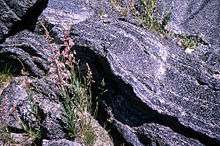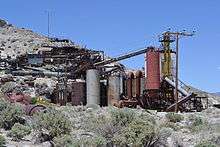Perlite
Perlite is an amorphous volcanic glass that has a relatively high water content, typically formed by the hydration of obsidian. It occurs naturally and has the unusual property of greatly expanding when heated sufficiently. It is an industrial mineral and a commercial product useful for its low density after processing. [1]

Properties

Perlite softens when it reaches temperatures of 850–900 °C (1,560–1,650 °F). Water trapped in the structure of the material vaporises and escapes, and this causes the expansion of the material to 7–16 times its original volume. The expanded material is a brilliant white, due to the reflectivity of the trapped bubbles. Unexpanded ("raw") perlite has a bulk density around 1100 kg/m3 (1.1 g/cm3), while typical expanded perlite has a bulk density of about 30–150 kg/m3 (0.03–0.150 g/cm3).[2]
Typical analysis
- 70–75% silicon dioxide: SiO2
- 12–15% aluminium oxide: Al2O3
- 3–4% sodium oxide: Na2O
- 3–5% potassium oxide: K2O
- 0.5-2% iron oxide: Fe2O3
- 0.2–0.7% magnesium oxide: MgO
- 0.5–1.5% calcium oxide: CaO
- 3–5% loss on ignition (chemical / combined water)[3]
Occurrence

Perlite is a non-renewable resource. The world reserves of perlite are estimated at 700 million tonnes.
The confirmed resources of perlite existing in Armenia amount to 150 million m3, whereas the total amount of projected resources reaches up to 3 billion m3.[4] Considering specific density of 1.1 ton/m3 confirmed reserves in Armenia amount to 136 mln. tons.
Other reported reserves are: Greece - 120 mln. tons, Turkey, USA and Hungary - about 49-57 mln. tons. [5][6]
Perlite world production led by China, Turkey, Greece, USA, Armenia and Hungary summed up to 4.6 mln. tons in 2018. [5][6]
Use
Because of its low density and relatively low price (about US$50 per tonne of unexpanded perlite), many commercial applications for perlite have developed. In the construction and manufacturing fields, it is used in lightweight plasters, concrete and mortar (masonry), insulation and ceiling tiles.[7] It may also be used to build composite materials that are sandwich-structured[8] or to create syntactic foam.[9] In horticulture, perlite can be used as a soil amendment or alone as a medium for hydroponics or for starting cuttings. When used as an amendment it has high permeability / low water retention and helps prevent soil compaction.[10] Perlite is an excellent filtration aid and is used extensively as an alternative to diatomaceous earth. The popularity of perlite usage as a filter medium is growing considerably worldwide. Perlite filters are fairly commonplace in filtering beer before it is bottled.
Small quantities of perlite are also used in foundries, cryogenic insulation, and ceramics (as a clay additive). It is also used by the explosives industry.[11] Due to thermal and mechanical stability, non-toxicity, and high resistance against microbial attacks and organic solvents, perlite is widely used in biotechnological applications. Perlite was found to be an excellent support for immobilization of biocatalysts such as enzymes for bioremediation and sensing applications.[12]
|
| ||||||||||||||||||||||||||||||||||||
Substitutes
Perlite can be substituted for all of its uses. Substitutes include:[16]
- Diatomite, used for filter-aids
- Expanded clay, an alternative lightweight filler for building materials
- Shale
- Pumice
- Slag
- Vermiculite - many expanders of perlite are also exfoliating vermiculite and belong to both trade associations
Occupational safety
As perlite contains silicon dioxide, goggles and silica filtering masks are recommended when handling large quantities.
United States
The Occupational Safety and Health Administration (OSHA) has set the legal limit (permissible exposure limit) for perlite exposure in the workplace as 15 mg/m3 total exposure and 5 mg/m3 respiratory exposure over an 8-hour workday. The National Institute for Occupational Safety and Health (NIOSH) has set a recommended exposure limit (REL) of 10 mg/m3 total exposure and 5 mg/m3 respiratory exposure over an 8-hour workday.[17]
See also
- Biochar, the large surface area of carbon molecules increases the soil structure, aeration, nutrient and water retention capacity. Biochar creates a healthy soil in which micro-organisms thrive
- Industrial minerals
- Mortar (firestop)
- Foam glass
References
- Reka, Arianit A.; Pavlovski, Blagoj; Lisichkov, Kiril; Jashari, Ahmed; Boev, Blažo; Boev, Ivan; Lazarova, Maja; Eskizeybek, Volkan; Oral, Ayhan; Makreski, Petre (24 October 2019). "Chemical, mineralogical and structural features of native and expanded perlite from Macedonia". Geologia Croatica. 72 (3): 215–221–215–221. doi:10.4154/gc.2019.18. ISSN 1333-4875. Retrieved 4 January 2020.
- Maxim, L. Daniel; Niebo, Ron; McConnell, Ernest E. (2014-04-01). "Perlite toxicology and epidemiology – a review". Inhalation Toxicology. 26 (5): 259–270. doi:10.3109/08958378.2014.881940. ISSN 0895-8378. PMC 4002636. PMID 24601903.
- Md Arifuzzaman and H. S. Kim, "Prediction and evaluation of density and volume fractions for the novel perlite composite affected by internal structure formation", Construction and Building Materials, Vol 141, 2017, 201–215.
- "General Information - Mining Resources - www.minenergy.am". www.minenergy.am. Retrieved 2019-06-10.
- M. Bennett, Shawnna. "USGS Mineral Commodity Summaries - PERLITE" (PDF). U.S. Geological Survey, Mineral Commodity Summaries.
- "Perlite Statistics and Information". www.usgs.gov. Retrieved 2019-06-10.
- Wallace P. Bolen Perlite USGS 2009 Minerals Yearbook
- Md Arifuzzaman and H. S. Kim, Novel flexural behaviour of sandwich structures made of perlite foam/sodium silicate core and paper skin, Construction and Building Materials, Construction and Building Materials, Vol 148 2017, pp 321–333.
- Dipendra Shastri and H. S. Kim, “A new consolidation process for expanded perlite particles”, Construction and Building Materials, Vol 60, June, 2014, pp.1–7.
- "ISU Extension News Release". iastate.edu. Archived from the original on 2004-03-23.
- Emulsion explosive composition containing expanded perlite United States Patent 4940497
- Torabi, Seyed-Fakhreddin; Khajeh, Khosro; Ghasempur, Salehe; Ghaemi, Nasser; Siadat, Seyed-Omid Ranaei (2007-08-31). "Covalent attachment of cholesterol oxidase and horseradish peroxidase on perlite through silanization: Activity, stability and co-immobilization". Journal of Biotechnology. 131 (2): 111–120. doi:10.1016/j.jbiotec.2007.04.015. PMID 17658643.
- Perlite, USGS Mineral Commodity Summaries 2011
- "PERLITE : (Data in thousand metric tons unless otherwise noted)" (PDF). Minerals.usgs.gov. Retrieved 22 October 2017.
- "Perlite" (PDF). U.S. Geological Survey Mineral Commodity Summaries: 122–123. January 2006.
- USGS Mineral Commodity Summaries (PDF), 2013
- "CDC – NIOSH Pocket Guide to Chemical Hazards – Perlite". www.cdc.gov. Retrieved 2015-11-27.
External links
| Wikimedia Commons has media related to Perlite. |
- The Perlite Institute
- Mineral Information Institute – perlite
- "That Wonderful Volcanic Popcorn." Popular Mechanics, December 1954, p. 136.
- CDC – NIOSH Pocket Guide to Chemical Hazards